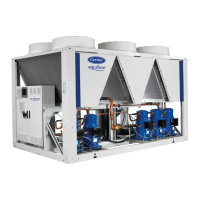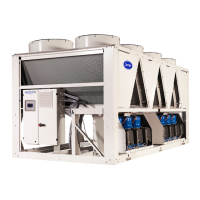11.5 - Electronic expansion valve (EXV)
The EXV has a stepper motor and a sight glass which can be used
to check the mechanism movement and the presence of the liquid
gasket.
11.6 - Moisture indicator
Located on the EXV, enables control of the unit charge and
indicates moisture in the circuit.
The presence of bubbles in the sight glass indicates an insucient
charge or non-condensables in the system.
The presence of moisture changes the colour of the indicator paper
in the sight glass (from green to yellow).
11.7 - Dehumidier lter
The role of the dehumidier lter is to keep the circuit clean and
moisture-free.
The moisture indicator shows when it is necessary to change the
element.
A dierence in temperature between the lter inlet and outlet shows
that the element is dirty.
11.8 - Refrigerant accumulator with built-in
lter drier
Specic data 30RQ/30RQP
The refrigerant charge required in cooling mode is greater than
the permissible refrigerant charge in heating mode. The
accumulator is used to store the excess charge in heating mode.
A removable element and metal lter keep the refrigerant circuit
clean and free from moisture, by capturing solid contaminants.
When the moisture indicator turns yellow, it is necessary to change
the element. When the unit is operating in cooling mode,
a dierence in temperature between the tank inlet and outlet
indicates fouling of the element and/or lter.
11.9 - Water type heat exchanger
The water type heat exchanger is a brazed plate heat exchanger
with two refrigerant circuits.
The hydraulic connections of the heat exchanger are Victaulic
connections.
The water type heat exchanger is thermally insulated with 19 mm
of foam.
As an option it can be protected against frost by an electric heater
(water exchanger frost protection option).
Any products used for thermal insulation of recipients during
hydraulic connection must be chemically neutral to the surfaces
on which they are applied. All original materials supplied by the
manufacturer comply with this requirement.
NOTE - Monitoring during operation
- Follow local regulations on the monitoring of pressure
equipment
- The user or the operator is usually requested to create
and maintain a monitoring and maintenance register.
- In the absence of any regulations, or in addition to the
regulations, follow the guidance in the EN 378 standard.
- Follow the local professional recommendations,
whenever they exist.
- Regularly check for the presence of any impurities
(e.g. sand, grit) in the heat-transfer fluids. These
impurities maybe the cause of the wear or corrosion by
puncture.
- The reports of the periodical checks by the user or the
operator must be included in the monitoring and
maintenance log.
11.10 - Refrigerant
Units operating with R32 (A2L uid).
Potentially ammable zones have been identied on the edge of
the unit: please refer to chapter “4.4 - Positioning of potentially
ammable zones around the unit”.
11.11 - High-pressure safety pressure switch
The units are equipped with high-pressure safety pressostats with
automatic reset.
These pressure switches are located at the discharge of each
circuit.
11.12 - Variable frequency drive
30RBP and 30RQP units are equipped with variable frequency
drives to control the fan speed within the fmin-fmax frequency
range (standard, fmin=5 Hz and fmax=50 Hz).
All fans on the same refrigerant circuit are actuated and controlled
by a single variable frequency drive. The fan is driven by generating
a supply waveform with a variable frequency and voltage,
generated by pulse width modulation.
Fan start-up/shut-down and the working range frequency setpoint
are controlled by the Controller through RS485 communication
using the LEN Protocol.
11 - MAIN COMPONENTS OF THE UNIT AND OPERATING CHARACTERISTICS
50

